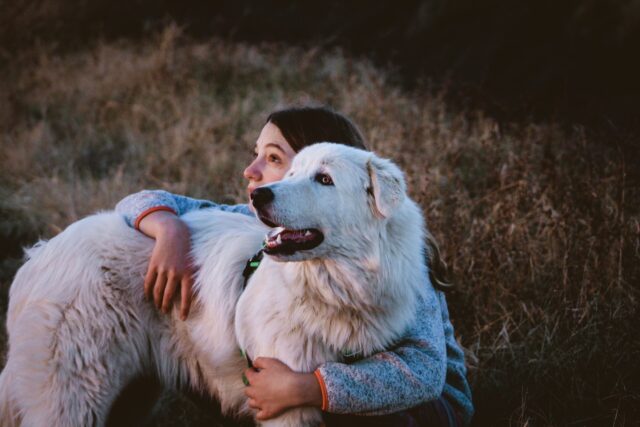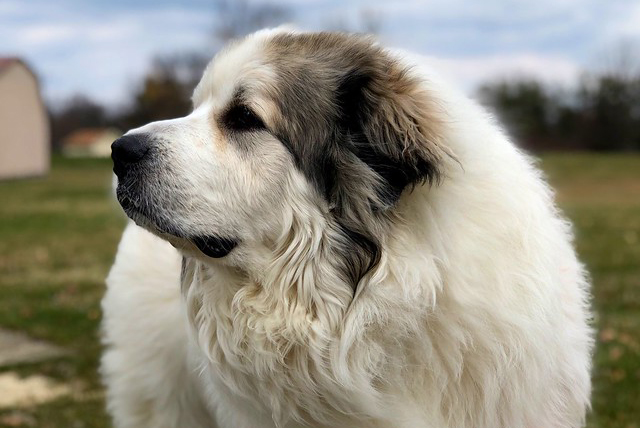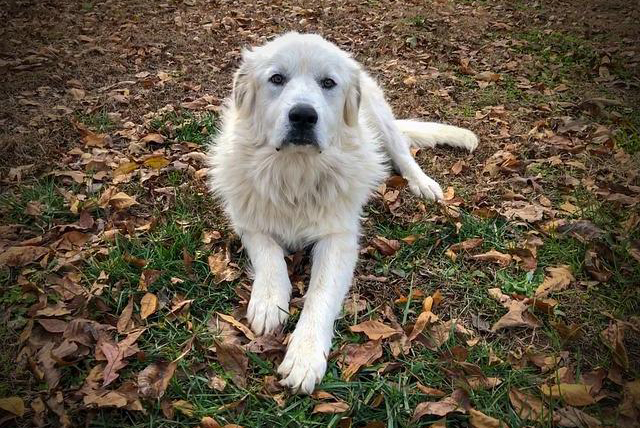iHeartDogs is reader-supported. When you buy via links on our site, we may earn an affiliate commission at no extra cost to you.

The French call them the Patou, but you call your Great Pyrenees your best buddy! There with you through thick and thin, these giant mountain dogs work hard and love even harder. Really, the Great Pyrenees is a big baby who wants all your affection. And though big, many of these sweet dogs consider themselves lap dogs. So, get ready because your extra-large floof will find a way to wiggle into your arms!
And because you want to be smushed under a 150 lbs. of pure angel dog for years to come, you’ll do anything and everything to keep your Great Pyrenees as happy as possible. And part of that ‘anything and everything’ is annual checkups with the vet to keep your pup fit and healthy. But no matter how diligent of a dog parent you are, illness and injury can still happen.
Great Pyrenees are prone to joint issues, Dilated Cardiomyopathy, eye problems, hypothyroidism, and cancer. Treating any of these problems can get expensive, but you can be financially prepared to fend off whatever comes with pet insurance for your Great Pyrenees. To help you find peace of mind and the best pet insurance plan for your Great Pyrenees, we’ve created a free and easy-to-use comparison tool to simplify the insurance quest.
Compare The Top 9 Pet Insurance Plans for Your Great Pyrenees Using our Free No-Obligation Quote Tool below
The simplest way to compare pet insurance prices is to use our tool below. The comparison tool will show you quotes from the top 9 pet insurance carriers, including Trupanion, Pets Best, Lemonade, ManyPets, FIGO, HealthyPaws, Prudent Pet, Spot, and Embrace pet insurance.
How Much Does Pet Insurance for a Great Pyrenees Cost?
Below are some sample pet insurance plans for a 1-year-old male Great Pyrenees using the zip code 75001 (Texas) as an example.
- Pets Best – $47.49 per month
- Embrace – $57.07 per month
- Healthy Paws – $59.13 per month
- ManyPets – $43.43 per month
Ultimately, your plan’s premium will depend on several factors, including your dog’s age, size, and breed, as well as where you live. You also want to know what type of coverage your plan has and if it will help with Great Pyrenees-specific health problems. Let’s get more into those medical conditions and how much you can expect to pay to treat them.
Common Health Problems Associated With Great Pyrenees
Joint Issues
Because of genetics and their impressive size, Great Pyrenees commonly develop joint problems brought on by dysplasia and patellar luxation. Each of these joint issues can cause pain and problems with mobility.
- Hip Dysplasia – Hip dysplasia occurs when the ball-and-socket joint in a dog’s hip doesn’t form correctly, leaving the joint to dislocate or the femur head to sit wrong in the socket.
- Elbow Dysplasia – Like hip dysplasia, elbow dysplasia is a genetic issue that causes abnormalities in the elbow joints.
- Luxating Patella – Known also as a dislocated kneecap, patellar luxation can be mild to severe.
Dilated Cardiomyopathy (DCM)
While the Great Pyrenees is a dog with a heart made for love, those sweet hearts can experience a problem with Dilated Cardiomyopathy (DCM). Brought on by genetics or acquired through age, DCM is a heart disease that causes cardiac muscles to dilate and thin, leading to pumping and blood flow problems. A Great Pyrenees with DCM may struggle to breathe, exhibit weakness and fatigue, lose interest in food, and even collapse if their heart is working overtime. This heart issue can lead to congestive heart failure in dogs and must be monitored by a veterinarian to maintain quality of life.
Eye Problems
Eye problems plague many dog breeds, but the Great Pyrenees experiences more than their fair share. And without proper treatment, these eye diseases and conditions could lead to permanent damage and blindness. Some of the common eye problems in the Great Pyrenees are:
- Progressive Retinal Atrophy (PRA) – This hereditary disease destroys the eye’s retina. PRA begins with night blindness and progresses to total vision loss over time.
- Entropion – Dogs that suffer from entropion have eyelids that roll inward, causing the eyelashes and skin of the lid to rub the sensitive surface of the eye and could lead to ulcers, infections, and even blindness.
- Ectropion – This severe drooping or outward roll of the eyelid exposes delicate eye tissues, causing dryness, inflammation, and even infection.
Hypothyroidism
Hypothyroidism is another common health problem in Great Pyrenees and occurs when the thyroid doesn’t produce enough hormones to regulate metabolism. This condition often presents with fatigue, weight gain, coat problems, and flaky skin. Once diagnosed, your dog will need lifelong veterinary management as there is currently no cure for hypothyroidism in dogs. Left untreated, your dog’s entire quality of life will decline.
Cancer
No matter the breed, cancer is one of the leading causes of death in dogs, with one in four likely to be diagnosed with some form of the disease. With every year that passes in your pup’s life, the risk increases as senior dogs are more likely to develop cancer than younger ones. Unfortunately, some breeds are more likely to develop cancer, and the Great Pyrenees is one, with higher instances of these two types of cancer:
- Hemangiosarcoma – cancer of the blood vessels
- Osteosarcoma – cancer of the bone usually seen near knees, shoulders, and wrist joints
Typical Costs Of Treating Health Issues In Great Pyrenees and How Pet Insurance Can Help
Taking your dog to the vet for annual visits is a bill you expect. But when the vet discovers a problem or emergency strikes, medical bills can stack up fast. With the right pet insurance plan for your Great Pyrenees, you’ll be financially ready to deal with any bills, leaving you to concentrate on your best friend’s recovery.
Have a look at what it costs to treat the Great Pyrenees health problems mentioned above:
- Joint Issues Costs: The treatment plan for your Great Pyrenees’ joint problems might consist of medications that help with pain and slow degeneration, and the cost of these monthly medications can add up over years of management. However, certain pet insurance plans can help you find relief from monthly prescription costs. But once the hips, elbows, or knees reach a certain point of degeneration, surgery may be needed and can run anywhere from $2,000 – $7,000. The right pet insurance plan for your Great Pyrenees can soften the financial blow of a $2,000 – $7,000 surgery.
- DCM Costs: To diagnose heart disease in dogs, vets will turn to X-rays, electrocardiograms, and echocardiograms, and this cardiac examination could cost an estimated $1,000. And though DCM in dogs can lead to eventual heart failure, heart medications can help slow deterioration. Your vet might prescribe quite the cocktail of medicines to manage heart disease, including ACE inhibitors, diuretics, nitroglycerin, vasodilators, and beta-blockers. These vital heart medications could run anywhere from $50 to $200 per month. Pet insurance plans that offer coverage on your Great Pyrenees’ prescriptions can save you big.
- Eye Problem Costs: Because the Great Pyrenees has a tendency toward eye problems, those big beautiful eyes can get expensive. For example, while there is no cure for Progressive Retinal Atrophy, diagnosing PRA involves an electroretinogram (ERG), a test that measures the electrical impulses of the eye. The average cost of an ERG is $400. And the average cost for eye surgeries to fix issues like entropion and ectropion can range from $400 to $2,000. Final prices of eye surgery or diagnostic tests will depend on the severity of your dog’s eye issues and your location. But, one thing is sure, having pet insurance for your Great Pyrenees before an eye problem occurs is a foresight that will protect your finances from high vet bills.
- Hypothyroidism Costs: Hypothyroidism is typically treated with medication and monitoring. Depending on the severity of the issue, you’re looking at $20 – $50 a month to fill your Great Pyrenees’ script. That might not sound like much to start, but month after month, year after year, prescriptions can add up over time. Getting an insurance plan for your Great Pyrenees that offers drug coverage or discounts before your dog develops hypothyroidism can help offset costs for this lifelong issue.
- Cancer Costs: When cancer is suspected, diagnostic costs for bloodwork, scans, and exploratory surgery can range from $200 to more than $1,500. Once the diagnosis comes, the treatment begins, and costs start mounting with surgery that averages $1,500, radiation prices of $2,000-$6,000, and chemotherapy costs that can climb to $5,000 depending on severity. Additional prescriptions can average $50 monthly, but quality pet insurance plans for Great Pyrenees can reduce cancer costs significantly.
What Is Pet Health Insurance, And Why Do I Need It For My Great Pyrenees?
Pet health insurance works very similarly to human health insurance. Your policy quote will range in monthly price, depending on your dog’s breed, age, and where you live. Typically, you’ll spend around $15-$103 per month as a pet parent.
Pet insurance is mainly about peace of mind, knowing you won’t be totally overwhelmed in case of an emergency. Enrolling even when your dog is young and healthy will ensure you have plenty of coverage when they need expensive medical care later. If you choose a plan more suited to your dog’s particular breed, you’ll be more prepared when something happens later on in their life.

Some plans cover accidents and illnesses, while others only cover accidents. Certain plans do cover breed-specific illnesses, and others do not. It all depends on what type of coverage you choose. With our free pet insurance comparison tool, you can get quotes from multiple insurance companies with no obligation to commit.
Whatever plan you choose, you’ll feel better knowing you can take care of your dog when they need you most. Plus, you won’t have to suddenly shell out thousands of dollars. Learn more about how pet insurance works here.
Pet Insurance Carrier Comparisons
- 9 Best Pet Insurance Plans for Dogs
- Best Cheap Pet Insurance
- Trupanion Vs. Pets Best Pet Insurance
- Trupanion Vs. Lemonade Pet Insurance
- HealthyPaws Vs. Embrace Pet Insurance
- HealthyPaws Vs. Trupanion Pet Insurance
- Embrace Vs. Trupanion Pet Insurance
- Embrace Vs. Lemonade Pet Insurance
- Trupanion Vs. FIGO Pet Insurance
- Prudent Pet Vs. Trupanion Pet Insurance
- Embrace Vs. ManyPets Pet Insurance
- Embrace Vs. FIGO Pet Insurance
- Prudent Pet Vs. Embrace Pet Insurance
- HealthyPaws Vs. ManyPets Pet Insurance
- HealthyPaws Vs. FIGO Pet Insurance
- Prudent Pet Vs. HealthyPaws Pet Insurance
- HealthyPaws Vs. Lemonade Pet Insurance
- Pets Best Vs. ManyPets Pet Insurance
- Pets Best Vs. FIGO Pet Insurance
- Prudent Pet Vs. ManyPets Pet Insurance
- Prudent Pet Vs. Pets Best Pet Insurance
- Embrace Vs. Pets Best Insurance
- HealthyPaws Vs. Pets Best Pet Insurance
- ManyPets Vs. Lemonade Pet Insurance
- Lemonade Vs. FIGO Pet Insurance
- Trupanion Vs. ManyPets Pet Insurance
- ManyPets Vs. FIGO Pet Insurance
- Lemonade Vs. Pets Best Pet Insurance
- Prudent Pet Vs. Lemonade Pet Insurance
- Prudent Pet Vs. FIGO Pet Insurance
Breed Pet Insurance
- Pet insurance for Akitas
- Pet insurance for Alaskan Malamutes
- Pet insurance for American English Coonhounds
- Pet insurance for American Staffordshire Terriers
- Pet insurance for Australian Cattle Dogs
- Pet insurance for Australian Shepherds
- Pet insurance for Basset Hounds
- Pet insurance for Beagles
- Pet insurance for Bernese Mountain Dog
- Pet insurance for Bichon Frises
- Pet insurance for Bloodhounds
- Pet insurance for Border Collies
- Pet insurance for Boston Terriers
- Pet insurance for Boxers
- Pet insurance for Bulldogs
- Pet insurance for Bullmastiffs
- Pet insurance for Bull Terriers
- Pet insurance for Cane Corsos
- Pet insurance for Cavaliers
- Pet insurance for Chesapeake Bay Retrievers
- Pet insurance for Chihuahuas
- Pet insurance for Chinese Crested Dogs
- Pet insurance for Chow Chows
- Pet insurance for Cocker Spaniels
- Pet insurance for Collies
- Pet insurance for Corgis
- Pet insurance for Dachshunds
- Pet insurance for Dobermans
- Pet insurance for Dogue De Bordeaux
- Pet insurance for English Springer Spaniels
- Pet insurance for French Bulldogs
- Pet insurance for German Shepherds
- Pet insurance for German Shorthaired Pointers
- Pet insurance for Goldendoodles
- Pet insurance for Golden Retrievers
- Pet insurance for Greyhounds
- Pet insurance for Great Danes
- Pet insurance for Great Pyrenees
- Pet insurance for Havanese
- Pet insurance for Huskies
- Pet insurance for Jack Russells
- Pet insurance for Labrador Retrievers
- Pet insurance for Labradoodles
- Pet insurance for Lhasa Apsos
- Pet insurance for Maltese
- Pet insurance for Mastiffs
- Pet insurance for Miniature Pinschers
- Pet insurance for Mixed Breeds (small)
- Pet insurance for Mixed Breeds (medium)
- Pet insurance for Mutts
- Pet insurance for Newfoundlands
- Pet insurance for Old English Sheepdogs
- Pet insurance for Papillons
- Pet insurance for Pekingese
- Pet insurance for Pit Bulls
- Pet insurance for Pomeranians
- Pet insurance for Poodles
- Pet insurance for Pugs
- Pet insurance for Rhodesian Ridgebacks
- Pet insurance for Rottweilers
- Pet insurance for Saint Bernards
- Pet insurance for Samoyeds
- Pet insurance for Schnauzers
- Pet insurance for Shar-Peis
- Pet insurance for Shelties
- Pet insurance for Shiba Inus
- Pet insurance for Shih Tzu
- Pet insurance for Staffordshire Bull Terrier
- Pet insurance for Vizslas
- Pet insurance for Weimaraners
- Pet insurance for Westies
- Pet insurance for Whippets
- Pet insurance for Yorkies
Pet Insurance by City
- Pet Insurance in San Diego
- Chicago Pet Insurance
- New York City Pet Insurance
- Pet Insurance in Seattle
- Pet Insurance in Los Angeles
- Pet Insurance in Austin
- Pet Insurance in San Antonio
- Pet Insurance in Miami
- Pet Insurance in Philadelphia
- Pet Insurance in Sacramento
- Pet Insurance in Orlando
- Pet Insurance in San Francisco
- Pet Insurance in Houston
- Pet Insurance in Dallas
- Pet Insurance in Tampa
- Pet Insurance in Pittsburgh
Pet Insurance by State
- Pet Insurance in California
- Pet Insurance in Texas
- Pet Insurance in Florida
- Pet Insurance in Pennsylvania
- Pet Insurance in Washington State
- Best Pet Insurance in Michigan
- State of Delaware Pet Insurance
- Pet Insurance in NC
- Pet Insurance in NJ
- Pet Insurance in Colorado
- Pet Insurance in Ohio
- Pet Insurance in Oregon
- Pet Insurance in Indiana
- Pet Insurance in Oklahoma
- Pet Insurance in Utah
- Pet Insurance in New York
- Pet Insurance in Massachusetts
- Pet Insurance in Arizona
- Pet Insurance in Minnesota
- Pet Insurance in Connecticut
- Pet Insurance in Wisconsin
- Pet Insurance in Hawaii
- Pet Insurance in Iowa
- Pet Insurance in New Hampshire
- Pet Insurance in Alabama
- Pet Insurance in Maine
- Pet Insurance in Maryland
- Pet Insurance in Rhode Island
- Pet Insurance in Arkansas
- Pet Insurance in Illinois
- Pet Insurance in Nebraska
- Pet Insurance in Alaska
- Pet Insurance in Louisiana
- Pet Insurance in South Carolina
- Pet Insurance in Vermont
- Pet Insurance in Georgia


 Toledo, United States.
Toledo, United States.